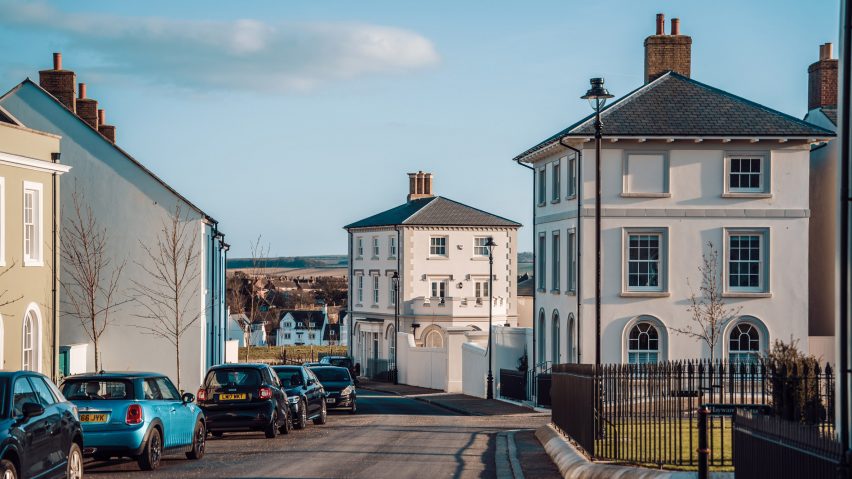The UK government's plan to encourage "gentle densification" of neighbourhoods by promising communities financial benefits and neo-Georgian aesthetics will not help solve the housing crisis, writes Anna Minton.
Street votes, mini referendums and design codes are the UK government's latest plan to solve England's housing crisis. Last month ministers introduced the Levelling Up and Regeneration Bill to parliament, setting out reforms to the planning system.
Announced less than a year after an earlier Planning Bill failed amid a backbench revolt among the government's own MPs, the hope is that these eye-catching – or harebrained depending on your perspective – proposals will persuade communities to build more homes.
If we build more homes then surely it makes sense that house prices will come down
Two elements stand out: the introduction of local ballots or "street votes" to allow neighbours to propose and approve new development, supported by "design codes" binding builders to council-agreed style parameters.
It's a narrative that rests on a number of assumptions underpinning the government's housing and planning policy. The first of these is that Britain has a housing crisis because we don't build enough homes as a result of NIMBYISM and a restrictive planning system.
This is sometimes called the supply-side argument: if we build more homes then surely it makes sense that house prices will come down.
The second assumption is that if people are given the chance to make money from their own homes they will. The national media stories about street votes focused on the idea they will give people a veto over their neighbours' extensions, but this misses the point.
The ministers' aim is to provide incentives for communities in suburban areas with plenty of space to come together to build more housing and make money from their land and property in the process. One former government advisor told me: "It makes sense in two-storey suburban areas – outer London boroughs like Bexley or Redbridge – you could get 100 flats on those sites and people could become millionaires. It gives people the chance to make money out of their neighbourhood."
Street-by-street votes sound interesting to some and a potential nightmare of bureaucracy and neighbourhood disputes to others
The Levelling Up and Regeneration Bill, with its proposals for street votes and mini referendums, is a supply-side solution premised on providing indirect financial incentives to achieve the community buy-in that the Planning Bill was spectacularly unable to do.
Those proposals, to speed up planning in agreed "renewal" and "growth" areas, were dropped as a result of fears that they would lead to political suicide following the Conservatives' huge defeat in the Chesham & Amersham by-election a year ago.
This idea, of persuading communities that they want more housing, originated in a report produced by the conservative think tank Policy Exchange. To calm NIMBY fears, votes are accompanied by proposals for design codes which are heavily influenced by the government's Building Better, Building Beautiful Commission, headed up by the late right-wing philosopher Roger Scruton.
These design codes will allow residents to determine local rules for development, such as building layouts or facade designs, with the hope that "beautiful" building, in the style of Georgian terraces or Prince Charles's Poundbury, will encourage what levelling up secretary Michael Gove described as "gentle densification".
Street-by-street votes sound interesting to some and a potential nightmare of bureaucracy and neighbourhood disputes to others. Whether or not home owners can come together to overcome the resistance of their neighbours to new housing is an open question.
The real problem is that in the context of the UK's acute housing crisis "gentle densification" will amount to little more than rearranging the deck chairs on the Titanic. And while the UK needs to build more housing, in particular genuinely affordable social housing, the housing crisis is the result of soaring property price inflation. Like the Planning Bill, these proposals do nothing to address this.
Housebuilders are building, but they are not building homes people can afford
The reason is that the housing market does not function like a pure market and is linked to global capital flows and foreign investment rather than local circumstances, which ensures that more supply alone will not bring prices down.
A visit to any prosperous English city centre, from London to York and Bristol to Manchester, provides immediate evidence that homes are being built, with cranes and clusters of towers of brand new luxury apartment buildings dominating skylines. But the homes are not remotely affordable for the majority of the populations of their cities and many of them are sold "off plan" straight to foreign investors, before they have even been built.
Many of these developments go ahead regardless of community buy-in, in the face of stiff local opposition. They are supported by public-private partnerships between local authorities and developers who are keen to build luxury apartment schemes on small city centre sites because they generate high income.
Housebuilders are building, but they are not building homes people can afford in places they want to live. Linked to this is the practice of "landbanking", by which housebuilders keep prices high by buying large amounts of land but limiting the rate of production.
When he was mayor of London, UK prime minister Boris Johnson said: "I don't want to expel any oligarchs. Their cranes are sprouting across the city and it's marvelous." The mood music towards oligarchs may have changed since Russia's invasion of Ukraine, but with cranes still sprouting across British cities, it is clear that the approach to housing is no different. Given that fact, it is difficult to see how design codes and street votes can amount to little more than window dressing.
Anna Minton is the author Big Capital: Who is London for? published by Penguin. She is a reader in architecture at the University of East London.
The photography, showing Prince Charles's Poundbury estate in Dorset, is by Ruben Hanssen.

